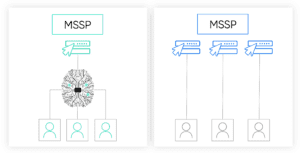Multitenancy – Why it’s crucial for MSSPs

Today, more SMBs are acknowledging that they are prime targets for hackers. As they know they lack the internal resources to hire an entire staff of cyber experts, they are turning to managed security service providers (MSSPs) for support.
That makes this an exciting and opportune time for MSSPs to grow but managing multiple clients with single-tenant solutions will cripple an MSSP’s efficiency, productivity, and profits.
With single-tenant solutions, MSSP employees waste valuable time logging into each client’s system and adjusting to each client’s console or dashboard. Additionally, a single-tenant approach means instances need to be deployed and configured for each client. The labor of doing this and the cost of running and maintaining single-tenant instances are more expensive as resources aren’t shared. All of this amounts to limited scalability and increased costs.
Some MSSPs will turn to a federated model, thinking that they can streamline their efforts by sending all alerts to a central console. While that is a step in the right direction, the event that triggered the alert remains in the client’s system, so to investigate it, one still needs to access the individual system. With events siloed, there’s no way to cross-correlate malicious events across multiple customers or automatically look for the event in other clients’ systems without manually creating a rule. In the end, this type of approach doesn’t save much in the way of productivity.
However, there is a better approach. Multitenant solutions enable MSSPs to manage multiple client environments from a single pane of glass.
What is a multitenant solution?
Multitenant architecture uses a single software instance to serve the needs of multiple users or clients in the case of MSSPs. The instance is divided into dedicated segments, so each client has their own, which can be configured to meet their exact requirements. MSSPs can use a multitenant solution to manage, monitor, and respond to each client’s security system from one centralized place, reducing costs, enabling scalability, and improving security responses.

For an MSSP interested in running an efficient, cost-effective business with modern tools and systems, a multitenant solution isn’t a nice-to-have – it’s a must, especially for those who want to remain highly competitive.
Benefits of a multitenant solution
There are many advantages for MSSPs that use multitenancy, and the benefit extends beyond them, trickling down to their clients as well.
A unified management platform
With a centralized management platform for all clients, MSSPs can react to potential threats and attacks quicker without moving back and forth between windows, tabs, or systems. MSSPs that select more advanced multitenant solutions will create subtenants to further partition the platform.
Direct access to client platforms
As long as the MSSP chooses a multitenant solution, they will be able to attend to all clients in one solution. With that process, MSSPs have direct access to all clients and can monitor and investigate any client’s platform easily, saving valuable time should an incident occur.
Role-based controls
Today’s compliance mandates and security requirements are stricter than ever. Role-based access control (RBAC) enables MSSPs to manage granular access levels for their tenants and themselves, amounting to improved operational efficiency without jeopardizing security.
Reduce reaction time and increase visibility
Since a multitenant solution offers a single management console, MSSPs gain unified visibility, giving them a single pane of glass that shows all clients’ alerts. When alerts and forensic data are consolidated in that way, security teams can prioritize and respond faster.
Shared threat data across customer portfolio
When high-risk threats are detected, mitigating them quickly is critical. As there is a strong likelihood that the same threat could appear in another client’s environment, MSSPs using a multitenant solution can quickly identify and mitigate that threat across all client environments.
Multitenancy: The MSSPs key to scaling and operational efficiency
Multitenancy is critical for optimizing systems and streamlining the management, monitoring, and response practices of an MSSP. Instead of security professionals having to onboard and learn each client’s security system, which is a waste of time and resources, they can learn one system that shows all clients and all alerts at once. Without a multitenant solution, teams will have to bounce around, and that’s exactly how dangerous threats slip through the cracks and go unnoticed.
As the trusted security gatekeeper for multiple clients, MSSPs can’t afford to have that happen. It puts their clients at risk along with their own reputations.
For MSSPs, multitenancy also offers a more affordable approach, both in terms of manpower and software resources. That can equate to offering more competitive prices for clients and, in turn, helping the MSSP scale its client base.
In short, there are no drawbacks to multitenancy, and the benefits are highly impactful. As more MSSPs look to gain an edge, they will turn to multitenant solutions, making it imperative to adopt the approach sooner rather than later. Those who don’t will quickly be left behind or forced to play catch up.


